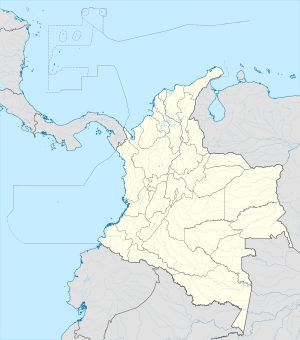Nemocón
| Nemocón | ||
|---|---|---|

Street in Nemocón
|
||
|
||
 Location of the town and municipality of Nemocón in the Cundinamarca Department |
||
| Location in Colombia | ||
| Coordinates: 5°3′19″N 74°1′17″W / 5.05528°N 74.02139°W | ||
| Country |
|
|
| Departamento | Cundinamarca | |
| Province | Central Savanna Province | |
| Founded | 26 July 1600 | |
| Founded by | Luis Henríquez | |
| Government | ||
| • Mayor | Renzo Alexander Sánchez Sabio (2016-2019) |
|
| Area | ||
| • City | 98.1 km2 (37.9 sq mi) | |
| • Urban | 0.61 km2 (0.24 sq mi) | |
| Elevation | 2,585 m (8,481 ft) | |
| Population (2015) | ||
| • City | 13,488 | |
| • Density | 140/km2 (360/sq mi) | |
| • Urban | 5,684 | |
| Demonym(s) | Nemoconense | |
| Time zone | Colombia Standard Time (UTC-5) | |
| Area code(s) | +1 | |
| Website | Official website | |
Nemocón is a municipality and town of Colombia in the Central Savanna Province, part of the department of Cundinamarca. Nemocón, famous for its salt mine, was an important village in the Muisca Confederation, the country in the central Colombian Andes before the arrival of the Spanish. The municipality is situated in the northern part of the Bogotá savanna, part of the Altiplano Cundiboyacense with its urban centre at an altitude of 2,585 metres (8,481 ft) and 65 kilometres (40 mi) from the capital Bogotá. Nemocón is the northeasternmost municipality of the Metropolitan Area of Bogotá and the Bogotá River originates close to Nemocón. The median temperature of Nemocón is 12.8 °C. The municipality borders Tausa in the north, Suesca in the east, Gachancipá and Zipaquirá in the south and in the west the rivers Checua and Neusa and the municipality of Cogua.
Nemocón is derived from Enemocón and means "The cry or sadness of the warrior" in the Chibcha language. Another etymology is that the town is named after zipa Nemequene.
Archaeological evidence surfaced by Gonzalo Correal Urrego in 1979 and Ana María Groot in 1992 has shown that Nemocón was inhabited early in the of the Altiplano Cundiboyacense. One of the oldest evidence of human settlement; lithic scraper tools, bone tools and the remains of food of the hunter-gatherers (deer, foxes, jaguars and rodents) has been dated at 7640 BP. The inhabitants of the area lived under rock shelters, similar to Tequendama.
...
Wikipedia


